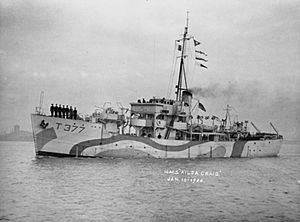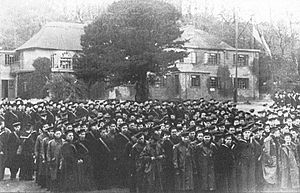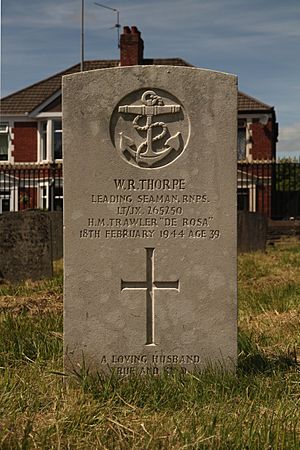Royal Naval Patrol Service facts for kids
Quick facts for kids Royal Naval Patrol Service |
|
|---|---|

The HMT Ailsa Craig, a minesweeping Isles-class trawler of the RNPS, 1944
|
|
| Active | 1914–1919, 1939-1945 |
| Country | |
| Branch | |
The Royal Naval Patrol Service (RNPS) was a special part of the Royal Navy. It was active during both the First and Second World Wars. The RNPS used many small ships, like naval trawlers. These ships helped protect Britain's coast and convoys. They did this by looking for submarines and clearing dangerous underwater bombs called mines.
Contents
The Royal Naval Patrol Service started during the Great War (World War I). This was when the British realized how dangerous mines in the sea could be. An admiral named Lord Charles Beresford suggested using fishing boats called trawlers from Grimsby. He thought they would be good for clearing mines.
Grimsby was a perfect choice because it had many docks and a large fishing fleet. The admiral believed that fishing boats would not be used for fishing during wartime. He also thought that fishermen would be better at handling the ropes and winches needed for minesweeping. This was because they already used similar equipment for fishing. The Admiralty Minesweeping Division worked through World War I. After the war, the trawlers went back to fishing, and the division was closed.
Training for Minesweeping Operations
Later, the Royal Navy understood that clearing mines was a key part of modern naval warfare. So, they started training sailors and officers in minesweeping. They added three trawlers to their training group. Training began again for the Trawler Section of the Royal Naval Reserve at Portland. This new group was called the Royal Naval Patrol Service.
As World War II approached, training became more intense. Sailors and officers practiced new ways to clear mines. They also improved equipment, like the Oropesa Sweep. This method was named after the trawler that first tried it in 1918.
In the summer of 1939, the Navy bought 67 trawlers and built 20 new ones. When World War II began, every minesweeper was ready for duty. HMS Europa, also known as Sparrow's Nest, became the main base for the Royal Naval Patrol Service. It was located in Lowestoft, the most easterly point of Britain. This made it the closest British military base to the enemy. The Lowestoft War Memorial Museum is now in the old RNPS headquarters building.
This eventually became the training and drafting base for more than 70,000 men, who manned 6,000 small craft of numerous types, including trawlers, whalers, drifters, MFVs (Motor Fishing Vessels), MLs (Motor Launches), and later MMS (Motor Minesweepers or "Mickey Mouses"), American produced BYMS (British Yard Mine Sweepers) and numerous requisitioned vessels.
Grimsby was very important again for minesweeping. It became the largest minesweeper base in Britain. The brave men of the sweepers cleared 34,858 mines from important sea routes.
Between 1942 and its decommissioning in 1946 new construction ships and craft manned by the Service totalled 1,637 of various kinds including converted trawlers, corvettes, fuel carriers, motor launches and naval seaplane tenders. Of this total, from September 1939 through to May 1945, approximately 260 trawlers were lost in action... This material loss however pales into insignificance when compared to the 15,000 or so, RNPS personnel who were killed in the Second World War, including the 2385 RNPS seaman who "have no known grave but the sea".
Using small ships for minesweeping was a good idea, first seen in World War I. Many peacetime fishermen were asked to join the Royal Naval Reserve. Because most of them were Reservists, the RNPS became like a "Navy within a Navy."
The RNPS used older, less powerful ships, like fishing trawlers. These ships were often crewed by former fishermen. Because of this, the RNPS got several funny nicknames. Some called it "Harry Tate's Navy," "Churchill's pirates," or "Sparrows."
The name 'Harry Tates' dates back to the First World War and was used as jargon for anything clumsy and amateurish. It originated from an old music hall entertainer who would play the clumsy comic who couldn't get to grips with various contraptions. His act included a car that gradually fell apart around him. By the start of World War II it had been adopted by the Royal Navy and used for the purpose of poking fun at the trawlers and drifters of the Royal Naval Patrol Service. In true RNPS style they took it on the chin and the title of Harry Tate's Navy was proudly adopted. As the war went on it was to become a worthy password for courage.
The fishermen who became naval seamen developed a strong bond. This friendship continued throughout World War II. Even by the end of the war, most RNPS members were "hostilities only" sailors. This meant they had joined just for the war and had little sea experience before.
The Royal Naval Patrol Service lost over 250 ships. This was more than any other part of the Royal Navy. Because of the dangers and losses, the men of the RNPS were honored. Prime Minister Churchill made a special statement about them. They also received a unique silver badge to wear on their uniform. This badge was given to those who served six months or more in the RNPS.
MESSAGE FROM THE PRIME MINISTER TO THE OFFICERS AND MEN OF THE MINESWEEPING FLOTILLAS
Now that Nazi Germany has been defeated I wish to send you all on behalf of His Majesty's Government a message of thanks and gratitude.
The work you do is hard and dangerous. You rarely get and never seek publicity; your only concern is to do your job, and you have done it nobly. You have sailed in many seas and all weathers... This work could not be done without loss, and we mourn all who have died and over 250 ships lost on duty.
No work has been more vital than yours; no work has been better done. The Ports were kept open and Britain breathed. The Nation is once again proud of you.
W S Churchill
Operations of the RNPS in World War II
The RNPS fought in all parts of the war. They were in the Arctic, the Mediterranean, the Atlantic, and the Far East. Their main jobs included protecting convoys, clearing mines, and hunting submarines. They were especially important for keeping the British coast clear of mines. These mines were causing a lot of damage to merchant ships.
One RNPS member, Lieutenant Richard Been Stannard, won the Victoria Cross. This is the highest award for bravery. He earned it while commanding the Hull trawler Arab during the Namsos campaign.
The RNPS used many different types of ships. Before World War II, the Grimsby class sloop was used for minesweeping and anti-submarine work. This class of ship was named after Grimsby, the port first suggested for minesweeping in 1907.
In 1933, four new Halcyon-class minesweepers were built. These were known as 'fast sweepers'. They were shorter than the Grimsby Class ships. Smaller ships with a shallow bottom were important for working safely in minefields. By 1939, as war became certain, the 'whale catcher' Flower-class corvettes were built. These were cheaper and faster to build.
As the war continued, the Navy bought 67 trawlers and ordered 20 more to be built for minesweeping. They knew trawlers were perfect for this job. Hundreds more ships were taken over by the Navy during the war. New ships were also developed, like the specially designed timber-hulled Motor MineSweepers (MMS class). These wooden ships were better protected from magnetic mines.
See also
- Auxiliary Patrol
- Royal Naval Reserve
- History of the Royal Naval Reserve
- Trawlers of the Royal Navy
- Coastal Forces of the Royal Navy




